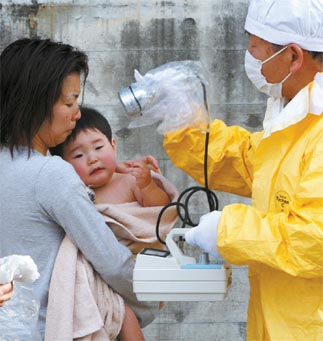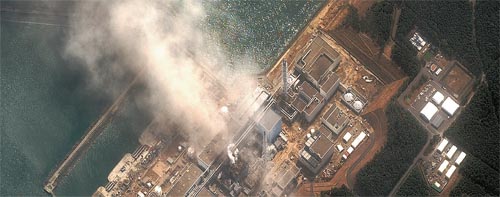World holds breath over Japan’s nuclear plant

A baby is checked for radiation exposure after being decontaminated in Fukushima, Japan, Monday. [AP/YONHAP]
The earthquake - now confirmed as a 9.0-magnitude quake by both the U.S. Geological Survey and the Japan Meteorological Agency - shook the plant, and the resulting tsunami crippled its cooling systems, causing fuel rods to become exposed to air, partially melting them.
Around 6:15 a.m. yesterday the No. 2 reactor at the Fukushima Daiichi plant suffered a hydrogen explosion, possibly damaging a tank used to relieve pressure in the reactor. At 11:12 a.m., a fire broke out at the No. 4 reactor, which burst into flames after spent fuel rods stored there supposedly overheated and caught fire.
Similar explosions had taken place at the plant’s No. 1 and No. 3 reactors in the past few days.
The situation is at a critical point as the primary containment vessel of the No. 2 reactor was damaged, with Tokyo Electric Power Co. saying that it could lead to a “meltdown” situation.
In a press briefing shortly after the fire at the No. 4 reactor, Prime Minister Naoto Kan said radiation levels had risen.
“The danger of a leak of radioactive material has been heightened,” said Kan. “Those living within 20 and 30 kilometers of the plant should not go outside but stay inside houses, offices and buildings.” People living within a 20-kilometer (12.4-mile) radius of the plant have already been evacuated for fear of radiation exposure. In the afternoon, a no-fly zone was announced by the Japanese government 30 kilometers above the nuclear plant.
“Operations were halted at the No. 4 reactor at the time the earthquake happened on March 11, and we believe that the explosion occurred because the heat of the core generated hydrogen and exploded,” said Chief Cabinet Secretary Yukio Edano.
Seawater is being used to cool the reactor cores since the first explosion occurred at the No. 1 reactor after the earthquake.

To help with the crisis, Japan has asked the United States for cooling equipment, Gregory Jaczko, chairman of the U.S. Nuclear Regulatory Commission, said in Washington. The commission has already sent two experts to the area. Japan has also reached out to the International Atomic Energy Agency for help, according to the director general of the IAEA.
There are a total of 11 reactors in the quake-stricken area in two different plants, only one of which shut down normally after the earthquake and stayed stable. Reactor No. 5 at the Fukushima Daiichi plant has also been reported to be “unstable” by local media, and there is no telling when another explosion or meltdown will occur. There is also concern about another large earthquake hitting Japan in the coming days.
The Japanese government has made it clear there will be no abandoning of the stricken power plant. The local press reported yesterday that the prime minister had said “pulling out of the Fukushima plant is something that cannot happen.”
“We have no one else but you,” Kan was cited as telling officials from Tokyo Electric Power Co., which owns the plants, during an emergency meeting convened at 5:30 a.m. “There can be no pulling out,” he said. “Please make your resolves clear.”

This satellite image provided by DigitalGlobe shows the damaged Fukushima Daiichi Nuclear Power Station in Japan on Monday. Authorities are struggling to prevent a catastrophic release of radiation. [AP/YONHAP]
According to the JoongAng Ilbo, Kan was suggesting workers sacrifice their lives for the safety of the country.
Due to the danger from the nuclear plant, a steady stream of people have been leaving the area for safer parts of Japan. From Sendai, the northern city battered by the tsunami, people were seen leaving in buses, the only remaining form of public transportation in the area. Most of them were heading for the western prefectures of Yamagata or Niigata.
Three-thousand Sendai citizens gathered in front of the Miyagi Prefecture Office at 7 a.m. yesterday morning to flee to Yamagata for 900 yen a head.
A Miyagi transportation official told the JoongAng Ilbo, “As long as the roads hold up, buses will leave every 20 to 30 minutes.”
People in the area were guarding themselves against exposure to radiation, the JoongAng Ilbo reported. People in Sendai, which is 130 kilometers away from the Fukushima plant, were seen covering themselves in hats, masks, coats and wool gloves.
Rain fell for the first time since the quake yesterday, and people in the street avoided it in case it was radioactive, darting into buildings or hastily opening up umbrellas.
“The government should not just tell us that everything is fine. They should reassure us with objective data,” said Geiko Ashino, 36, who doubts the prime minister’s advice to stay inside. Japanese Internet users have also been posting their fears of radiation exposure, and one user on a popular Japanese online community wrote: “I think I must prepare to die.”
Korea’s Ministry of Foreign Affairs and Trade advised Korean nationals to evacuate the area in a statement yesterday.
“We have found that there are 1,700 Korean-Japanese and roughly 1,000 Korean students, businessmen and people belonging to religious groups in the region of Fukushima,” said Lee Su-jon, the head of the emergency response team sent from the Foreign Ministry. “The Korean government has announced that nationals near the nuclear plant should quickly move to safe locations. The area within a 30-kilometer radius of the plant should not be entered.”
The Korean government doesn’t know how many of its nationals are within that radius.
The Korean Consulate in Sendai received roughly 240 requests from Korean nationals to return to Korea and 109 of them were moved to Niigata Airport yesterday, said Lee.
When asked why information on Korean deaths from the quake and tsunami was not being released quickly, Lee explained that the “sheer number of bodies, many of them which do not carry identification” was one of the main problems.
Meanwhile, the Korean government, has decided to beef up monitoring of Japanese livestock and aquatic products for radioactivity. The Ministry for Food, Agriculture, Forestry and Fisheries said products made in Japan after March 12 will be subject to radioactivity screenings on a weekly basis until April 30. Monitoring will take place once a month in May and June.
According to the ministry, Korea imported 84,018 tons of aquatic products and 527 tons of livestock products from Japan last year.
Vice Minister of Knowledge Economy Ahn Hyun-ho said yesterday that Korea would re-examine the safety of its own nuclear plants from the bottom up.
“We will re-examine the safety of nuclear power plants with other related ministries like the Ministry of Education, Science and Technology,” said Ahn at the National Assembly. “The lesson of the accidents in Japan is that there can be natural disasters that exceed our preparations.”
By Christine Kim [christine.kim@joongang.co.kr]
Related Korean Article[중앙일보]
간 총리 “원전 철수는 없다, 각오해 달라”
후쿠시마 원전 2호기 폭발 격납용기 손상 … 방사능 대량 유출, 도쿄서도 검출
간 총리 비장한 주문
“(도쿄전력) 당신들밖에 없다. 철수는 있을 수 없다. 각오해 달라. (후쿠시마 원전에서) 철수하는 순간 도쿄전력은 100% 박살날 것이다. TV에서 ( 원전 폭발 장면이) 방영되고 있는데 총리 관저에는 1시간 정도 연락 없었다. 어떻게 된 일이냐. (원전 상태가) 호전되는 상황이 아니다. 낙관할 수 없다.”
후쿠시마(福島) 원자력 발전소에서 잇따른 폭발 소식이 전해진 15일. 간 나오토(菅直人) 일본 총리의 하루는 ‘비상(非常)’의 연속이었다.
새벽 5시30분 간 총리는 총리관저에서 ‘후쿠시마 원전 사고대책 통합연락본부’의 출범을 직접 발표했다. 그는 “무슨 일이 있어도 이 위기를 이겨내기 위해 내가 진두지휘해 내겠다”고 선언한 뒤 곧바로 본부가 설치되는 도쿄 우치사이초(內幸町)의 도쿄전력 본사 2층으로 향했다. 도쿄전력은 후쿠시마 원전을 운영하는 회사다. 정부 각료들과 도쿄전력 임원들이 참석한 대책회의에서 간 총리는 “(도쿄전력이)후쿠시마 원전에서 철수한다는 건 있을 수 없는 일”이라며 “당신들밖에 없다. 철수란 있을 수 없다. 각오를 단단히 해달라”고 당부했다고 지지(時事)통신 등 일본 언론들이 보도했다.
경고도 서슴지 않았다고 한다. 간 총리는 “(도쿄전력이 후쿠시마 원전에서)철수하는 순간 도쿄전력은 100% 박살날 것(망한다는 의미)”이라고 강조했다. 특히 “(후쿠시마 원전의 폭발이) TV에서 방영되고 있는데 총리 관저에는 1시간 정도 연락이 없었다. 도대체 어떻게 된 일이냐”고 불쾌감까지 토로했다고 한다.
간 총리의 분노가 폭발한 건 그동안 도쿄전력이 낙관적인 전망으로 일관해 왔다는 불신감에서였다. 대책회의는 3시간 가까이 이어졌다.
통합 연락본부장은 간 총리가 직접 맡았고, 부본부장은 가이에다 반리(海江田萬里) 경제산업상과 시미즈 마사다카(清水正孝) 도쿄전력 사장이 맡았다. 가이에다 경제산업상과 호소노 고시(細野豪志) 총리 보좌관은 아예 본부가 설치된 도쿄 우치사이초(內幸町)의 도쿄전력 본사에 상주시키기로 결정했다.
이날 간 총리가 도쿄전력을 찾아 강도 높은 발언을 하자 야당인 자민당의 이시하라 노부테루(石原伸晃) 간사장은 “민간기업에 총리가 가서 그런 말을 하는 건 옳지 않다”고 비판했다. 하지만 간 총리로선 그런 걸 따질 상황이 아니었다. 도쿄전력을 나서는 간 총리의 얼굴은 벌겋게 상기된 상태였다. 총리 관저로 돌아올 때 “피난 범위를 넓힐 것이냐”는 기자들의 질문에도 입술을 꼭 깨물 뿐 아무 말도 하지 않았다.
오전 11시 간 총리는 TV카메라 앞에 섰다. ‘국민에게 드리는 말씀’이란 제목의 대국민 담화를 발표하기 위해서였다. 작업복 차림의 그는 비장한 표정으로 “그동안 모든 수단을 동원해 원자로를 냉각시키기 위해 시도했으나 (후쿠시마 제1원전) 1호기· 3호기에서 수소가 발생해 폭발했고, 4호기도 화재가 발생해 방사능 농도가 상당히 높아졌다”고 말했다. 그런 뒤 침통한 표정으로 “방사능 물질의 누출 위험이 커졌다”며 “후쿠시마 원전에서 20㎞ 범위는 모두 피난했지만 이 범위 밖에서도 최대한 피난해야 한다”고 강조했다. “원전 20~30㎞의 주민들은 (외출을 삼가고) 실내에 대기하라”고도 당부했다.
대국민 담화는 호소조로 마무리됐다. 간 총리는 “어떻게 해서든 이 이상의 누출 확대를 막도록 전력을 다해 나가겠다. 국민 모두께선 걱정이 크시겠지만 제발 냉정하게 대처해 주시길 마음으로부터 부탁드린다. 국민에 대한 나의 부탁이다”고 말했다.










with the Korea JoongAng Daily
To write comments, please log in to one of the accounts.
Standards Board Policy (0/250자)